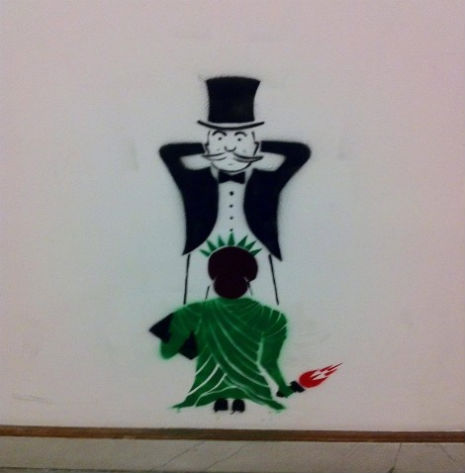
10. Capitalist corporations suffer from a personality disorder characterized by enduring antisocial behavior, diminished empathy and remorse, and are rewarded by shareholders for acting that way. If corporations could be sent to a criminal psychologist’s office they’d be diagnosed as psychopaths and locked away forever.

9. Capitalism encourages greed. But greed is only good for capitalists. For normal people it is anti-social and soul destroying, not to mention very bad for our communities, which rely on altruism, compassion and a generalized concern for others.

8. Capitalism is a system of minority privilege and class rule based on the private ownership of means of livelihood. This gives a few rich people the power to buy and sell jobs, which means they can build or destroy entire communities that depend on those jobs.

7. Capitalists praise freedom and individualism, but they destroy freedom and individualism for everyone but themselves. The vast majority of us who work for a living are daily asked to uncritically follow orders, to act as if we are machines, and limit our creativity to what profits our bosses.

6. Capitalists denigrate cooperation and collectivism, but create mass production processes that rely on both from workers. Their system requires us to be cogs in a giant profit-making machine, but because they fear the power this gives us we are told working together for our own interests is illegitimate and bad. Thus capitalists undermine unions and other organizations that encourage workers to cooperate with each other and act collectively.

5. Capitalism requires the largest propaganda system the world has ever known to convince us it is the only system possible. It turns people into consumers through advertising, marketing, entertainment and even so-called news. Millions around the world are employed to use their creativity to twist our feelings of love, desire, human solidarity and fairness into tools of manipulation, so that ever more profits can flow into the hands of a tiny minority.

4. Capitalism is a system in which the principle of one dollar, one vote, dominates that of one person, one vote. Those who own the most shares (bought with their dollars) control giant corporations, many of which are more powerful than all but a few governments. Rich people also use their money to dominate the elections that are supposed to give us all one, equal vote. Under capitalism those with the most money are entitled to the most goods and services as well as the most say in directing our governments and our economy.

3. Capitalism proclaims the virtue of naked self-interest, but self-interest without regard for morality, ecology or common sense leads to environmental degradation, destruction of indigenous communities, colonialism, war and other forms of mass destruction. Self-interest leads capitalists to seek profit absolutely everywhere, regardless of the damage done to other people and the health of the planet’s ecosystem. Self-interest leads capitalists to destroy any rival economic system or way of thinking (such as indigenous communal land use and respect for nature) that can be a barrier to their endless quest for profit.

2. Capitalism is not a friend to democracy but ultimately its enemy. When pushed, capitalists choose capitalism over democracy. If people use democracy to weaken the power of capitalists the rich and powerful turn to various forms of fascism in order to keep their privileges.

1. Capitalism is a cancer taking over our planet. Capitalists make profits from global warming, from destroying our oceans, from pumping ever more chemicals into the atmosphere and from patenting everything they can, including life itself. Only by getting rid of capitalism can we rescue our environment.
This is a guest post from Gary Engler. It originally ran on Rabble. Engler is a Canadian journalist, novelist (The Year We Became Us, about the Saskatchewan Doctors Strike) and co-author of the recently released The New Commune-ist Manifesto: Workers of the World It Really is Time to Unite
. You can find more of his work at the New Communeist website

























